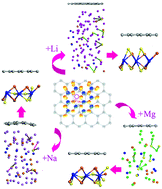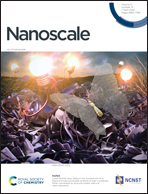Atomic-scale investigation of enhanced lithium, sodium and magnesium storage performance from defects in MoS2/graphene heterostructures
Abstract
MoS2 is of great interest as an anode material of batteries due to its high theoretical reversible capacity; in particular, a defective MoS2/graphene heterostructure exhibits excellent cycling stability. However, very little is known about the diffusion and ion storage mechanism at the atomistic level. To provide insights into the issue, we have developed and used first principles calculations and an atom intercalation/deintercalation algorithm to model the adsorption, diffusion, insertion and removal of Li, Na and Mg in pristine and defective MoS2/graphene systems. First, the adsorption of Li, Na and Mg is generally more stable in the defective MoS2/graphene structure. Mg and Li prefer to diffuse in the structure with disulfide defects, while Na prefers to diffuse in the molybdenum defective structure. Next, we found that the atomic configurations of both pristine and defective MoS2/graphene are not restored to their original states after the insertion and removal of Li, Na and Mg, which is related to the irreversible capacity loss of the system. Furthermore, by excluding the amount of lithium atoms related to the unrestored sulfur atoms, an algorithm was proposed to calculate the reversible capacity and it was verified by experimental results. We have also demonstrated that the introduction of defects leads to significant increase in the theoretical capacities of the Na and Mg systems, however, decreasing the capacity retention rate of Mg.



 Please wait while we load your content...
Please wait while we load your content...